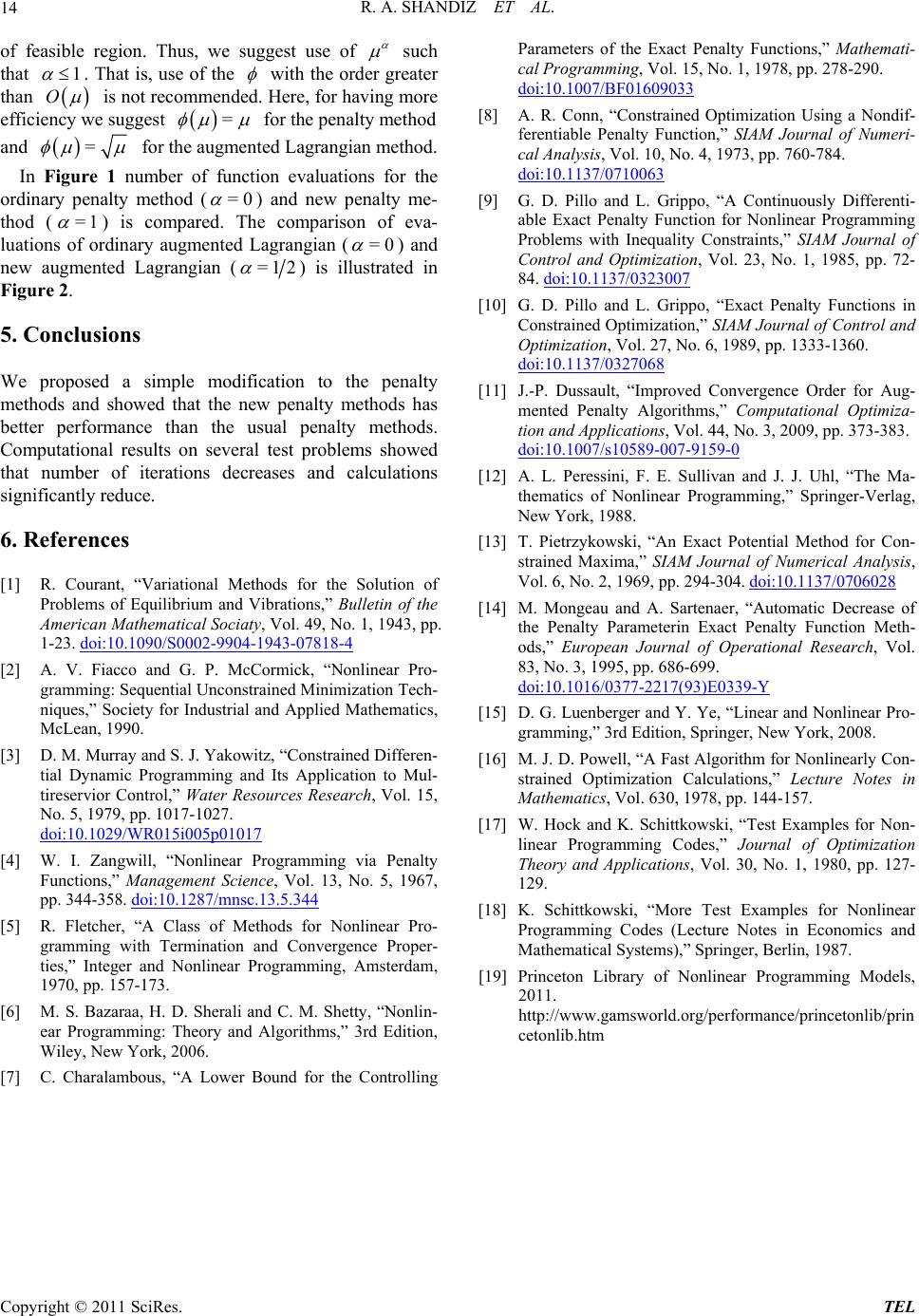
R. A. SHANDIZ ET AL.
Copyright © 2011 SciRes. TEL
14
of feasible region. Thus, we suggest use of
such
that 1
. That is, use of the
with the order greater
than
O
is not recommended. Here, for having more
efficiency we suggest
=
for the penalty method
and
=
for the augmented Lagrangian method.
In Figure 1 number of function evaluations for the
ordinary penalty method (=0
) and new penalty me-
thod (=1
) is compared. The comparison of eva-
luations of ordinary augmented Lagrangian (=0
) and
new augmented Lagrangian (=12
) is illustrated in
Figure 2.
5. Conclusions
We proposed a simple modification to the penalty
methods and showed that the new penalty methods has
better performance than the usual penalty methods.
Computational results on several test problems showed
that number of iterations decreases and calculations
significantly reduce.
6. References
[1] R. Courant, “Variational Methods for the Solution of
Problems of Equilibrium and Vibrations,” Bulletin of the
American Mathematical Sociaty, Vol. 49, No. 1, 1943, pp.
1-23. doi:10.1090/S0002-9904-1943-07818-4
[2] A. V. Fiacco and G. P. McCormick, “Nonlinear Pro-
gramming: Sequential Unconstrained Minimization Tech-
niques,” Society for Industrial and Applied Mathematics,
McLean, 1990.
[3] D. M. Murray and S. J. Yakowitz, “Constrained Differen-
tial Dynamic Programming and Its Application to Mul-
tireservior Control,” Water Resources Research, Vol. 15,
No. 5, 1979, pp. 1017-1027.
doi:10.1029/WR015i005p01017
[4] W. I. Zangwill, “Nonlinear Programming via Penalty
Functions,” Management Science, Vol. 13, No. 5, 1967,
pp. 344-358. doi:10.1287/mnsc.13.5.344
[5] R. Fletcher, “A Class of Methods for Nonlinear Pro-
gramming with Termination and Convergence Proper-
ties,” Integer and Nonlinear Programming, Amsterdam,
1970, pp. 157-173.
[6] M. S. Bazaraa, H. D. Sherali and C. M. Shetty, “Nonlin-
ear Programming: Theory and Algorithms,” 3rd Edition,
Wiley, New York, 2006.
[7] C. Charalambous, “A Lower Bound for the Controlling
Parameters of the Exact Penalty Functions,” Mathemati-
cal Programmi n g, Vol. 15, No. 1, 1978, pp. 278-290.
doi:10.1007/BF01609033
[8] A. R. Conn, “Constrained Optimization Using a Nondif-
ferentiable Penalty Function,” SIAM Journal of Numeri-
cal Analysis, Vol. 10, No. 4, 1973, pp. 760-784.
doi:10.1137/0710063
[9] G. D. Pillo and L. Grippo, “A Continuously Differenti-
able Exact Penalty Function for Nonlinear Programming
Problems with Inequality Constraints,” SIAM Journal of
Control and Optimization, Vol. 23, No. 1, 1985, pp. 72-
84. doi:10.1137/0323007
[10] G. D. Pillo and L. Grippo, “Exact Penalty Functions in
Constrained Optimization,” SIAM Journal of Control and
Optimization, Vol. 27, No. 6, 1989, pp. 1333-1360.
doi:10.1137/0327068
[11] J.-P. Dussault, “Improved Convergence Order for Aug-
mented Penalty Algorithms,” Computational Optimiza-
tion and Applications, Vol. 44, No. 3, 2009, pp. 373-383.
doi:10.1007/s10589-007-9159-0
[12] A. L. Peressini, F. E. Sullivan and J. J. Uhl, “The Ma-
thematics of Nonlinear Programming,” Springer-Verlag,
New York, 1988.
[13] T. Pietrzykowski, “An Exact Potential Method for Con-
strained Maxima,” SIAM Journal of Numerical Analysis,
Vol. 6, No. 2, 1969, pp. 294-304. doi:10.1137/0706028
[14] M. Mongeau and A. Sartenaer, “Automatic Decrease of
the Penalty Parameterin Exact Penalty Function Meth-
ods,” European Journal of Operational Research, Vol.
83, No. 3, 1995, pp. 686-699.
doi:10.1016/0377-2217(93)E0339-Y
[15] D. G. Luenberger and Y. Ye, “Linear and Nonlinear Pro-
gramming,” 3rd Edition, Springer, New York, 2008.
[16] M. J. D. Powell, “A Fast Algorithm for Nonlinearly Con-
strained Optimization Calculations,” Lecture Notes in
Mathematics, Vol. 630, 1978, pp. 144-157.
[17] W. Hock and K. Schittkowski, “Test Examples for Non-
linear Programming Codes,” Journal of Optimization
Theory and Applications, Vol. 30, No. 1, 1980, pp. 127-
129.
[18] K. Schittkowski, “More Test Examples for Nonlinear
Programming Codes (Lecture Notes in Economics and
Mathematical Systems),” Springer, Berlin, 1987.
[19] Princeton Library of Nonlinear Programming Models,
2011.
http://www.gamsworld.org/performance/princetonlib/prin
cetonlib.htm